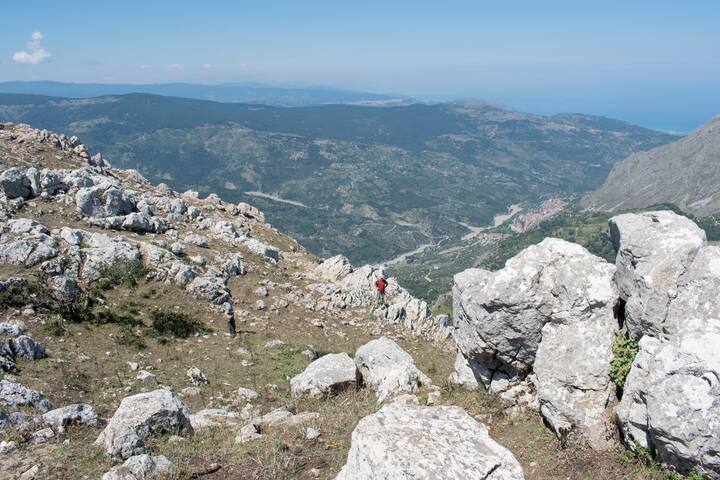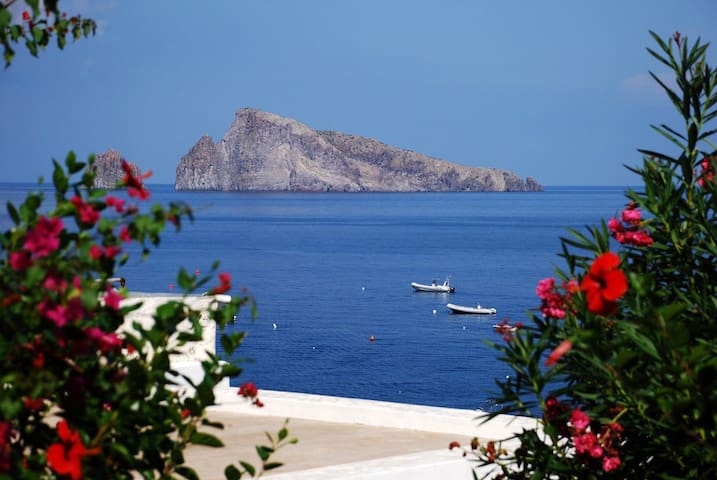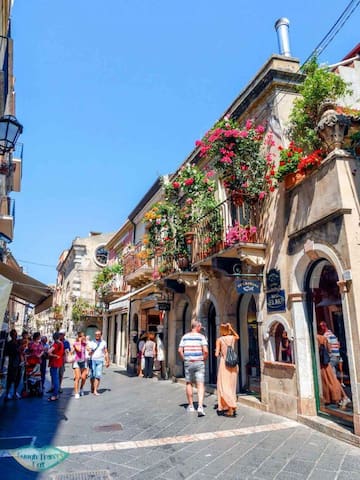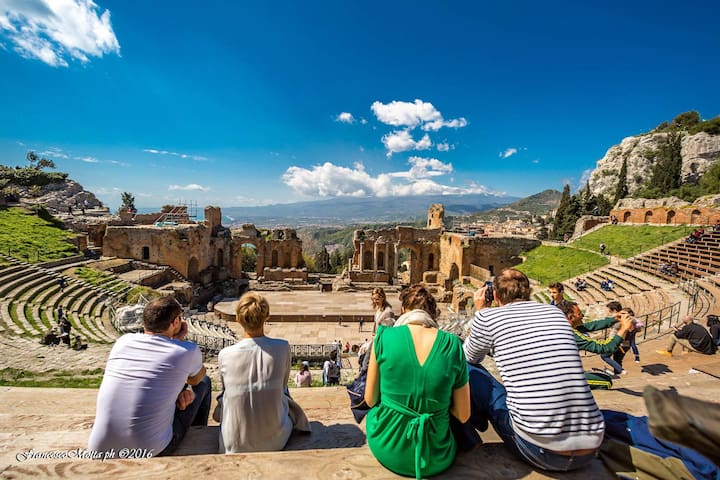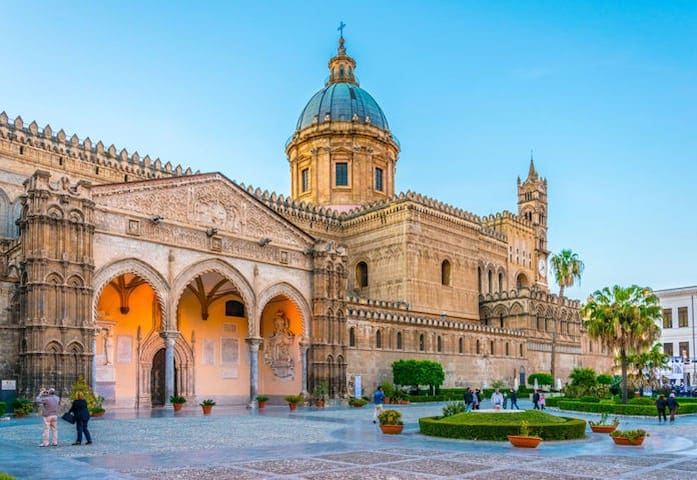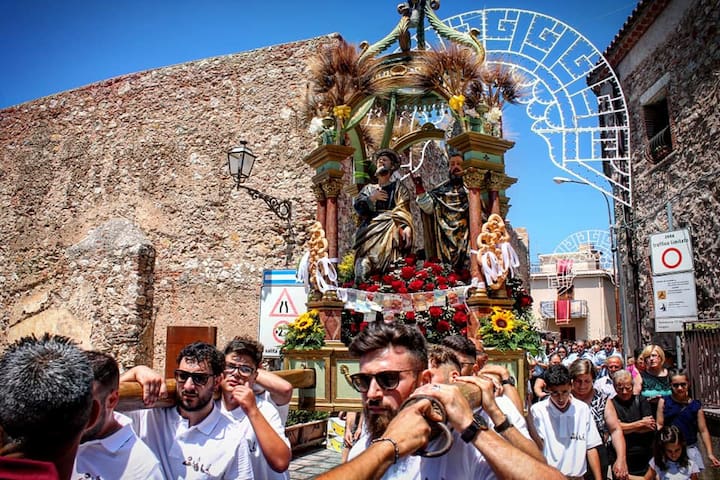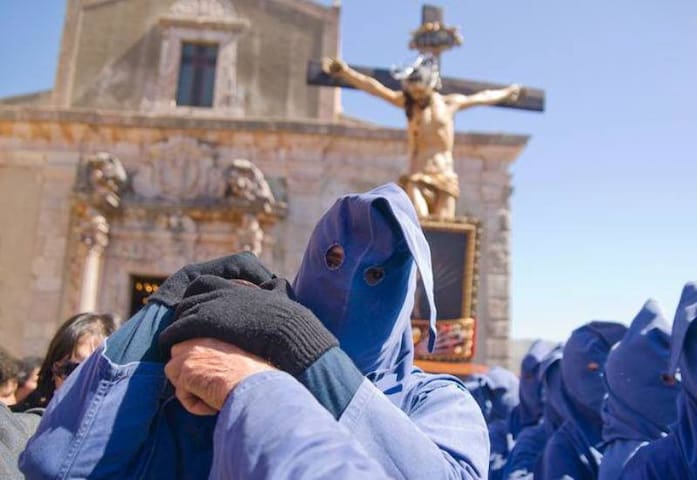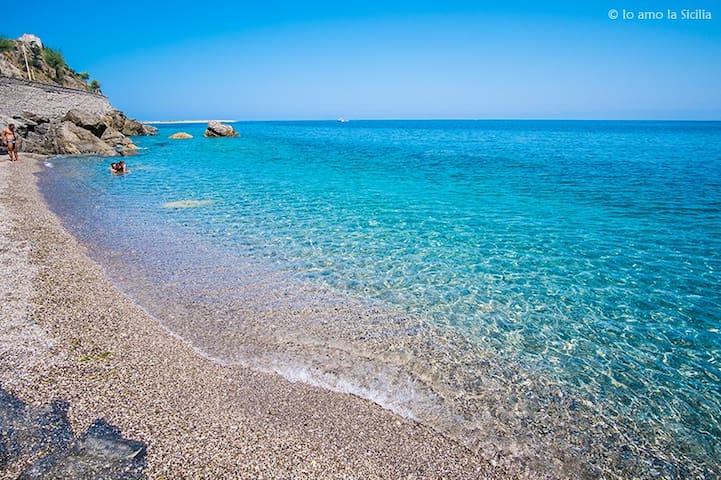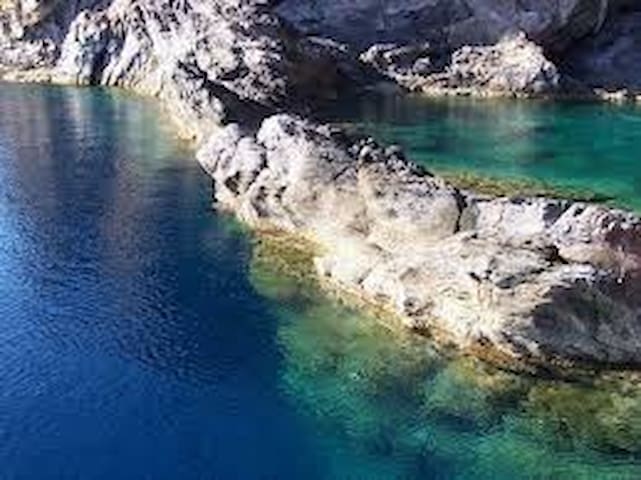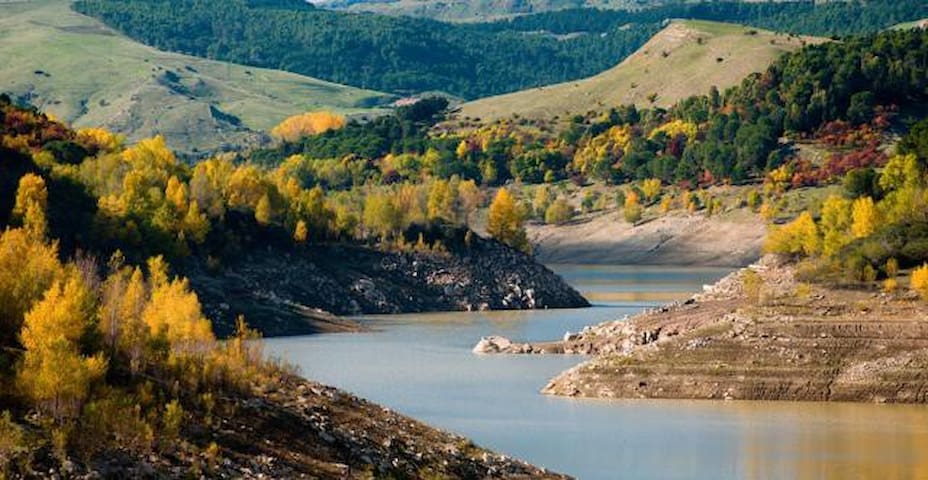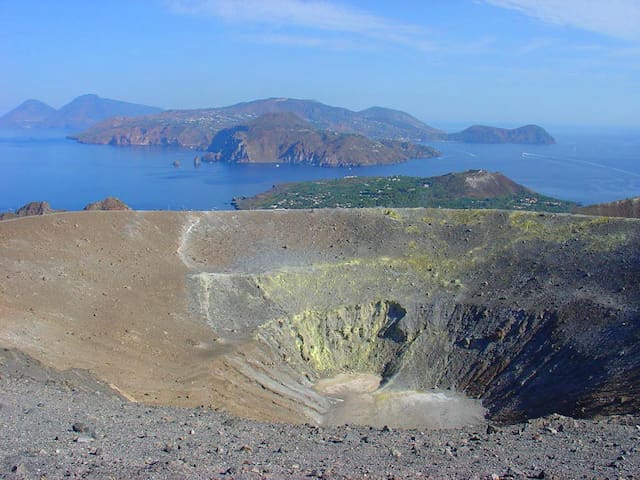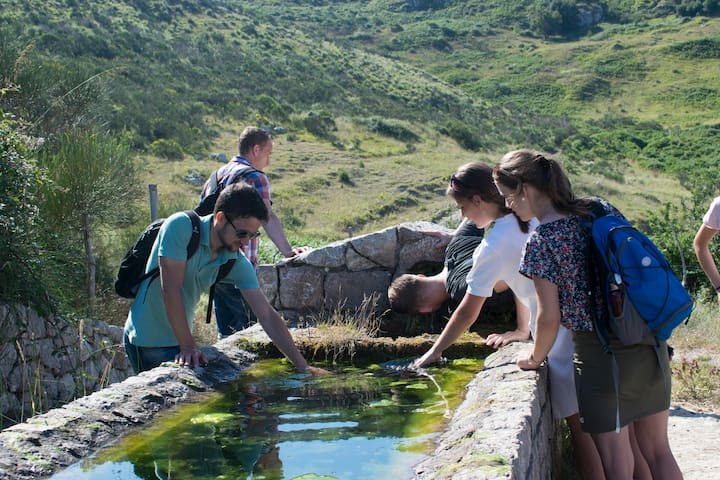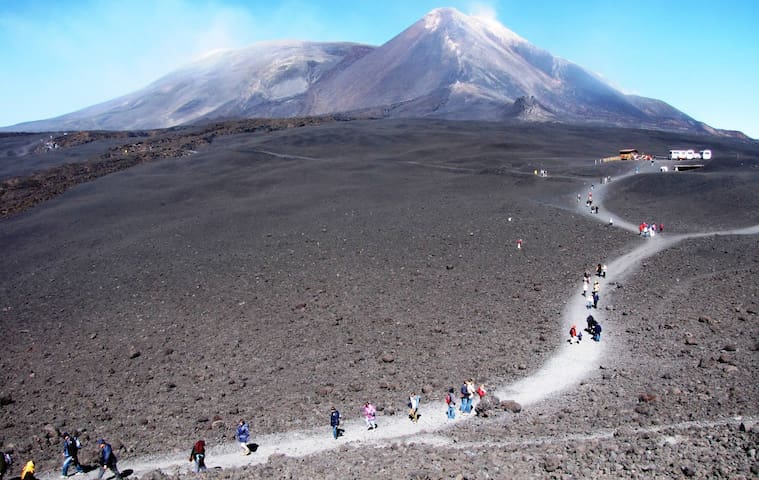Traditional feast of the patron saint
Discover San Marco d'Alunzio, the ancient Sicilian village where our accommodations are, authentic and not yet affected by tourism, through its centuries-old traditions.
During the following months
*March Babbaluti's feast.
*Easter Week
*July-Aug San Marco d'Alunzio celebrates the protector of the village.
San Marco d'Alunzio is getting ready to live the patronal feast, preparations are in full swing for an event that has been going on for more than two centuries, from July 30th to August 2nd. Lights, merry-go-rounds, stalls, band concerts, fireworks games will be the setting for one of the most heartfelt feasts for the little ones. To dominate the scene will still be them, St. Mark, St. Nicholas and St. Basil the Great, protectors of the community, protagonists of four days of intense faith and prayer, which will leave little room for expensive entertainment and worldly that sometimes characterize the feasts patronal of the district. The center of San Marco d'Alunzio will be filled with devotees, curious and visitors, many are the migrants who will return, for the occasion, in their native village.
The 30th of July and the 1st of August are the days of the vigil: at sunset at the Mother Church the Holy Mass with Vespers and the procession through the streets of the old town with the relics, the 30th of St. Mark and St. Nicholas and the 1st of St. Basil.
The 31st of July is the solemnity of the Patron Saints Mark and Nicholas, after the Mass at 11 a.m. there will be a procession with the statues of these saints. In the evening, at 19, the first procession of St. Basil.
August 2nd is the feast of the Protector St. Basil the Great. On this day there are many appointments of faith and prayer for the Saint. Unique in its kind are the processions of St. Basil on the evening of July 31 and the day of August 2, which see his statue, carried on the shoulders of the faithful, make a continuous comings and goings in the streets of the city, this characteristic that involves the continuation of the processions for long hours.
These sudden and sudden changes in the direction of travel of the fercolo are commonly referred to as "the journeys", because it is popular belief that during this coming and going the Saint listens to the requests of the faithful and performs miracles. Throughout the procession, the bearers exclaim loudly: "RAZZI SAMMASILI! ACCLAMAMULU CU NA VERA FIRI, VIVA DIU E SAMMASILI" (Grant us thanks oh San Basilio! Let us acclaim it with true faith, live God and Saint Basil).
In addition, the procession of St. Basil the Great, in addition to seeing the participation of hundreds of faithful and two band bodies, is characterized by the presence of men and women bearing large votive candles covered with basil and flowers, commonly called "torches" that flood the atmosphere with the intense smell of basil, such ceremonial artifacts are a tribute to the saint for a grace that you ask or that you have already received. These four intense days of celebration will end with the fireworks display at midnight on August 2.
21 명의 현지인이 추천하는 곳
San Marco d'Alunzio
San Marco d'Alunzio is getting ready to live the patronal feast, preparations are in full swing for an event that has been going on for more than two centuries, from July 30th to August 2nd. Lights, merry-go-rounds, stalls, band concerts, fireworks games will be the setting for one of the most heartfelt feasts for the little ones. To dominate the scene will still be them, St. Mark, St. Nicholas and St. Basil the Great, protectors of the community, protagonists of four days of intense faith and prayer, which will leave little room for expensive entertainment and worldly that sometimes characterize the feasts patronal of the district. The center of San Marco d'Alunzio will be filled with devotees, curious and visitors, many are the migrants who will return, for the occasion, in their native village.
The 30th of July and the 1st of August are the days of the vigil: at sunset at the Mother Church the Holy Mass with Vespers and the procession through the streets of the old town with the relics, the 30th of St. Mark and St. Nicholas and the 1st of St. Basil.
The 31st of July is the solemnity of the Patron Saints Mark and Nicholas, after the Mass at 11 a.m. there will be a procession with the statues of these saints. In the evening, at 19, the first procession of St. Basil.
August 2nd is the feast of the Protector St. Basil the Great. On this day there are many appointments of faith and prayer for the Saint. Unique in its kind are the processions of St. Basil on the evening of July 31 and the day of August 2, which see his statue, carried on the shoulders of the faithful, make a continuous comings and goings in the streets of the city, this characteristic that involves the continuation of the processions for long hours.
These sudden and sudden changes in the direction of travel of the fercolo are commonly referred to as "the journeys", because it is popular belief that during this coming and going the Saint listens to the requests of the faithful and performs miracles. Throughout the procession, the bearers exclaim loudly: "RAZZI SAMMASILI! ACCLAMAMULU CU NA VERA FIRI, VIVA DIU E SAMMASILI" (Grant us thanks oh San Basilio! Let us acclaim it with true faith, live God and Saint Basil).
In addition, the procession of St. Basil the Great, in addition to seeing the participation of hundreds of faithful and two band bodies, is characterized by the presence of men and women bearing large votive candles covered with basil and flowers, commonly called "torches" that flood the atmosphere with the intense smell of basil, such ceremonial artifacts are a tribute to the saint for a grace that you ask or that you have already received. These four intense days of celebration will end with the fireworks display at midnight on August 2.
Visite turistiche
A paradise for griffon vultures and the golden eagle, the Rocche del Crasto are made up of smooth, shiny crystalline rocks and white and pink dolomite limestone.
They reach a height of 1314 m. On the summit are still visible traces of an ancient fortified center, with the remains of a fortress and a watchtower, probably of Byzantine origin (sixth century AD, about).
Rocche del Crasto
A paradise for griffon vultures and the golden eagle, the Rocche del Crasto are made up of smooth, shiny crystalline rocks and white and pink dolomite limestone.
They reach a height of 1314 m. On the summit are still visible traces of an ancient fortified center, with the remains of a fortress and a watchtower, probably of Byzantine origin (sixth century AD, about).
Rising out of the cobalt-blue seas off Sicily's northeastern coast, the Unesco-protected Aeolian Islands (Vulcano, Lipari, Salina, Panarea, Stromboli, Filicudi and Alicudi) are a little piece of paradise, a seven-island archipelago offering a wealth of opportunities for relaxation and outdoor fun. Stunning waters provide sport for swimmers, sailors, kayakers and divers, while trekkers can climb hissing volcanoes and gourmets can sip honey-sweet Malvasia wine.
139 명의 현지인이 추천하는 곳
Lipari
Rising out of the cobalt-blue seas off Sicily's northeastern coast, the Unesco-protected Aeolian Islands (Vulcano, Lipari, Salina, Panarea, Stromboli, Filicudi and Alicudi) are a little piece of paradise, a seven-island archipelago offering a wealth of opportunities for relaxation and outdoor fun. Stunning waters provide sport for swimmers, sailors, kayakers and divers, while trekkers can climb hissing volcanoes and gourmets can sip honey-sweet Malvasia wine.
Aeolian Islands
Vulcano
Santo Stefano di Camastra is a village located on the provincial road that runs along the sea about 50 kilometers east of Cefalù. The village has developed around the handicraft production of Sicilian ceramics, of which today is the largest producer of the island. Along the way you will find many shops with adjoining factory that display the colorful artifacts: plates, cups, jugs, jugs, pottery, friezes, holy water, gifts of various kinds, tiles. All decorated with typical Sicilian paintings taken from the ancient tradition of the island to paint the Sicilian caretti, now famous throughout the world. Many ceramics today has become an industrial production, but there are still small craftsmen who make fine ceramics strictly handmade.
51 명의 현지인이 추천하는 곳
Santo Stefano di Camastra
Santo Stefano di Camastra is a village located on the provincial road that runs along the sea about 50 kilometers east of Cefalù. The village has developed around the handicraft production of Sicilian ceramics, of which today is the largest producer of the island. Along the way you will find many shops with adjoining factory that display the colorful artifacts: plates, cups, jugs, jugs, pottery, friezes, holy water, gifts of various kinds, tiles. All decorated with typical Sicilian paintings taken from the ancient tradition of the island to paint the Sicilian caretti, now famous throughout the world. Many ceramics today has become an industrial production, but there are still small craftsmen who make fine ceramics strictly handmade.
Beautiful Cefalù offers a rare combination of tourist attractions: one of Sicliy's finest beaches side-by-side with one of its greatest Arab-Norman architectural masterpieces. The squares, streets and churches of this medieval town are so postcard-pretty that it's no wonder director Giuseppe Tornatore chose to set parts of his much-loved film Cinema Paradiso here.
You won't be alone in admiring Cefalù's honey-hued stone buildings, mosaic-adorned cathedral and dramatic mountain backdrop. Holidaymakers from all over Europe flock here to relax in resort hotels, stroll the narrow cobbled streets and sun themselves on the long sandy beach – and the opening of a brand-new flagship Club Med here in 2018 has only magnified the crowds.
The town is perfectly suited to slow, pedestrianised exploration. The little port is lined with fishing boats and populated with fishermen who can be observed maintaining their boats, mending their nets and discussing the day's catch.
401 명의 현지인이 추천하는 곳
Cefalù
Beautiful Cefalù offers a rare combination of tourist attractions: one of Sicliy's finest beaches side-by-side with one of its greatest Arab-Norman architectural masterpieces. The squares, streets and churches of this medieval town are so postcard-pretty that it's no wonder director Giuseppe Tornatore chose to set parts of his much-loved film Cinema Paradiso here.
You won't be alone in admiring Cefalù's honey-hued stone buildings, mosaic-adorned cathedral and dramatic mountain backdrop. Holidaymakers from all over Europe flock here to relax in resort hotels, stroll the narrow cobbled streets and sun themselves on the long sandy beach – and the opening of a brand-new flagship Club Med here in 2018 has only magnified the crowds.
The town is perfectly suited to slow, pedestrianised exploration. The little port is lined with fishing boats and populated with fishermen who can be observed maintaining their boats, mending their nets and discussing the day's catch.
Randazzo
Taormina Shop
타오르미나 고대 극장
1 Via del Teatro GrecoPalermo
빌라로마나델카살레
SP90Tindari
Eventi
Discover San Marco d'Alunzio, the ancient Sicilian village where our accommodations are, authentic and not yet affected by tourism, through its centuries-old traditions.
During the following weeks
*March (21/03/2020 - 28/03/2020) Babbaluti's feast.
*July-Aug (25/07/2020 - 08/08/2020) San Marco d'Alunzio celebrates the protector of the village.
Among the festivities celebrated in S. Marco d'Alunzio, one of the most characteristic is undoubtedly that of S. Marco, S. Nicola and S. Basilio Magno, which takes place from July 30 to August 2.
On July 31st the Patron Saints Mark and Nicholas are celebrated, in the afternoon there is the ENTRATA R'ADDAURU and on the same evening, the simulacrum of St. Basil the Great from his church is transferred to the Mother Church.
The short journey that separates the two churches is covered in about two hours because St. Basil makes the trips that is goes back and forth as it is popular belief that during this coming and going, He performs miracles.
Day 2 August is the feast of St. Basil: the vara, adorned with flowers and fragrant basil, is carried on the shoulders of devotees who implore the graces screaming: Razii, S.Basili! And call it "cu cu vera firi"! Viva Diu and San Basili! (Thank you St. Basil! And let us call him with true faith! Long live God and St. Basil!).
The procession that takes place under the sun, is always characterized by the travels of the saint and by dozens of TORCE brought by the devotees, who precede and follow the vara (the torches are candles about a meter high decorated with basil, flowers, ribbons and scarves). In the evening St. Basil is brought back to his church.
21 명의 현지인이 추천하는 곳
San Marco d'Alunzio
Among the festivities celebrated in S. Marco d'Alunzio, one of the most characteristic is undoubtedly that of S. Marco, S. Nicola and S. Basilio Magno, which takes place from July 30 to August 2.
On July 31st the Patron Saints Mark and Nicholas are celebrated, in the afternoon there is the ENTRATA R'ADDAURU and on the same evening, the simulacrum of St. Basil the Great from his church is transferred to the Mother Church.
The short journey that separates the two churches is covered in about two hours because St. Basil makes the trips that is goes back and forth as it is popular belief that during this coming and going, He performs miracles.
Day 2 August is the feast of St. Basil: the vara, adorned with flowers and fragrant basil, is carried on the shoulders of devotees who implore the graces screaming: Razii, S.Basili! And call it "cu cu vera firi"! Viva Diu and San Basili! (Thank you St. Basil! And let us call him with true faith! Long live God and St. Basil!).
The procession that takes place under the sun, is always characterized by the travels of the saint and by dozens of TORCE brought by the devotees, who precede and follow the vara (the torches are candles about a meter high decorated with basil, flowers, ribbons and scarves). In the evening St. Basil is brought back to his church.
If you're not from the village, you'll know it as "Babbaluti's Day".
The babbaluti, for the inhabitants of San Marco d'Alunzio, are only one component of the "Feast of the Crucifix" that is repeated for centuries, the last Friday of March. It is a rite between paganism and religiosity that has been perpetuated for centuries, since San Marco d'Alunzio, a small village in Messina, thirty-three people, as many as there were years of Christ, hooded with blue saucers, began to accompany the ferculum carrying it on their shoulders.
The feast opens in Sicily the rites of Holy Week and is the most heartfelt by the people of Alghero. Emigrants and pilgrims reach the small village to take part in the celebrations dedicated to the contemplation of the passion of Jesus.
The babbaluti carry the vara with Christ on the Cross, a wooden work of 1652 and recently restored, and a painting depicting Our Lady of Sorrows being pierced by seven swords. Babbaluti means penitents and therefore people who repent of their sins and barefoot, wearing the "Piruna", the heavy woolen socks of sheep handmade, cry out to the crucifix their repentance. See the video...
The babbaluti take sides with the vara and with long wooden rods support the crucifix and the painting while one of them, the head, walks backwards, always looking towards the crucifix. All together they repeat in unison, for hours, the phrase "Signuri, misericordia, pieta!
Among them there are also women, who like men ask for a grace or thank you for that received. Those who don't want to risk being recognized also wear gloves.
The Friday celebrations opened with the Holy Mass at 9:00 a.m. followed by the Chaplet contemplating the five wounds of the Body of Jesus; at 11:00 a.m. then, the Solemn Mass followed by a brief procession of the Corpus Christi along the external perimeter of the Church.
Once the Eucharistic Jesus has been placed in the tabernacle, the statue of Jesus Crucified and the canvas depicting the Virgin of the Seven Sorrows are placed on the altar; the Cross placed on the ferrule, together with the painting of the Virgin Mary, is given to the Babbots.
With the ferculum of Jesus and the Madonna on their shoulders, the Babbots cross the streets of the characteristic village of Messina, leaving the echo of a whining invocation that penetrates into the depths of hearts: "Signuri, misericordia, pietà!". When the procession returns to the church, the ferculus is temporarily placed in the central nave. The solemn services resume in the afternoon, at 4 p.m., when the people around the Crucifix contemplate the 14 stations of the Cross. After the pious exercise of the Way of the Cross, the statue of the Crucifix and the painting of the Madonna are placed in the tomb.
21 명의 현지인이 추천하는 곳
San Marco d'Alunzio
If you're not from the village, you'll know it as "Babbaluti's Day".
The babbaluti, for the inhabitants of San Marco d'Alunzio, are only one component of the "Feast of the Crucifix" that is repeated for centuries, the last Friday of March. It is a rite between paganism and religiosity that has been perpetuated for centuries, since San Marco d'Alunzio, a small village in Messina, thirty-three people, as many as there were years of Christ, hooded with blue saucers, began to accompany the ferculum carrying it on their shoulders.
The feast opens in Sicily the rites of Holy Week and is the most heartfelt by the people of Alghero. Emigrants and pilgrims reach the small village to take part in the celebrations dedicated to the contemplation of the passion of Jesus.
The babbaluti carry the vara with Christ on the Cross, a wooden work of 1652 and recently restored, and a painting depicting Our Lady of Sorrows being pierced by seven swords. Babbaluti means penitents and therefore people who repent of their sins and barefoot, wearing the "Piruna", the heavy woolen socks of sheep handmade, cry out to the crucifix their repentance. See the video...
The babbaluti take sides with the vara and with long wooden rods support the crucifix and the painting while one of them, the head, walks backwards, always looking towards the crucifix. All together they repeat in unison, for hours, the phrase "Signuri, misericordia, pieta!
Among them there are also women, who like men ask for a grace or thank you for that received. Those who don't want to risk being recognized also wear gloves.
The Friday celebrations opened with the Holy Mass at 9:00 a.m. followed by the Chaplet contemplating the five wounds of the Body of Jesus; at 11:00 a.m. then, the Solemn Mass followed by a brief procession of the Corpus Christi along the external perimeter of the Church.
Once the Eucharistic Jesus has been placed in the tabernacle, the statue of Jesus Crucified and the canvas depicting the Virgin of the Seven Sorrows are placed on the altar; the Cross placed on the ferrule, together with the painting of the Virgin Mary, is given to the Babbots.
With the ferculum of Jesus and the Madonna on their shoulders, the Babbots cross the streets of the characteristic village of Messina, leaving the echo of a whining invocation that penetrates into the depths of hearts: "Signuri, misericordia, pietà!". When the procession returns to the church, the ferculus is temporarily placed in the central nave. The solemn services resume in the afternoon, at 4 p.m., when the people around the Crucifix contemplate the 14 stations of the Cross. After the pious exercise of the Way of the Cross, the statue of the Crucifix and the painting of the Madonna are placed in the tomb.
San Fratello
Easter Week - Festa dei Giudei
Beaches
Visitors come here for the beaches, both sandy and rocky, that are on either side of town. The best swimming is to the east.
56 명의 현지인이 추천하는 곳
Capo d'Orlando
Visitors come here for the beaches, both sandy and rocky, that are on either side of town. The best swimming is to the east.
Spiaggia di Mazzaforno
마리넬로 호수 보호구
Coastal crystal clear pool, edged by rocks, at the tip of a peninsula accessed by a scenic footpath.
47 명의 현지인이 추천하는 곳
비너스의 수영장
Via Sant'AntonioCoastal crystal clear pool, edged by rocks, at the tip of a peninsula accessed by a scenic footpath.
Hiking
LOCATION
Cefalù, Italy
Location of La Rocca on map© Mapbox© OpenStreetMap contributors
Looming over Cefalù, this imposing rocky crag was once the site of an Arab citadel, superseded in 1061 by the Norman castle whose ruins still crown the summit. To reach the top, follow signs for Tempio di Diana, taking Vicolo Saraceni off Corso Ruggero or Via Giuseppe Fiore off Piazza Garibaldi. The 30- to 45-minute route climbs the Salita Saraceni, a winding staircase, through three tiers of city walls before emerging onto rock-strewn upland slopes with spectacular coastal views.
107 명의 현지인이 추천하는 곳
로카디세팔루
LOCATION
Cefalù, Italy
Location of La Rocca on map© Mapbox© OpenStreetMap contributors
Looming over Cefalù, this imposing rocky crag was once the site of an Arab citadel, superseded in 1061 by the Norman castle whose ruins still crown the summit. To reach the top, follow signs for Tempio di Diana, taking Vicolo Saraceni off Corso Ruggero or Via Giuseppe Fiore off Piazza Garibaldi. The 30- to 45-minute route climbs the Salita Saraceni, a winding staircase, through three tiers of city walls before emerging onto rock-strewn upland slopes with spectacular coastal views.
네브로디 공원
Cratere di Vulcano
Rocche del Crasto
Etna Vulcano Guide
106 Via Umberto I

